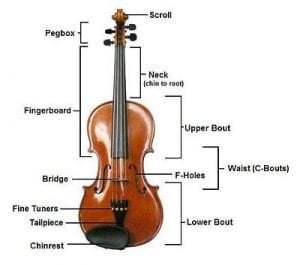“The stage is the best experience in the world. It’s a great compliment to be able to share the music…”
-Vanessa Mae
Pluck the Strings before using the bow
If you’re a violinist or a violist, you can put the instrument on your shoulder, or hold it under your arm like a guitar. The point is to use your right hand to pluck your strings. If you learned to put fingers down already, try putting some down and plucking. You should get a solid, resounding pitch. If you get a short, cut-off sound, the connection of your fingers are not strong enough.

Use online violin apps
Online music apps have come a long way and some of them are designed especially for the violin. If private instruction is outside the budget, take advantage of good music apps to gain extra support, accessing tips, video lessons, sheet music, violin-specific exercises, and so on.

Don’t give in to the, “I’m too tired…” line
If you succumb to the idea that you’re too tired to practice, you’ll lose momentum quickly. If nothing else, take the violin out for 5- or 10-minutes to practice scales or a few measures of new music. Even that little bit is exponentially better than nothing.

Listen to yourself
When learning how to manage the violin physically, it is sometimes hard to concentrate on how you sound. And because the violin is placed so close to the left ear, it is not always easy to get a real sense of how the performance sounds to others. Record your practice as often as you can. Listen back, looking for positives as well as points you want to improve.
Work on scales and technique
Technical exercises and scales are the building blocks of violin music. Working on these simple patterns out of context of the repertoire gives an opportunity to improve intonation and tone production across the board. Scales also help teach an understanding of key. You’ll find loads of scales and technical exercises in our resource library.

Find out about the music
All music, no matter how simple, comes with some historical and social context. Is your piece based on a dance or a song? Who was the composer, and when was it written. For more substantial pieces, it can be interesting to find out why the work was composed and what was going on in the composer’s life at the time. If someone had fallen in love or was suffering from depression, those feelings will be reflected in the music and might inform how you choose to express certain phrases.
Tighten the bow.
The hair of the bow should be limp. Tighten the bow hair by turning the end screw clockwise until the space between the hair and the stick is big enough to pass a pencil through cleanly from tip to tip.

The Basics of Violin Construction
In some respects most every violin is the same—four strings stretched over a small body, a tailpiece and chinrest at one end, and a neck and pegbox at the other. Most violins don’t offer the design variations that many modern instruments have, but any violin player will tell you that all violins are not created equal.
The key factors that determine each violin’s tone and playability are the quality of its tonewoods and the skill with which it is constructed.

Violins can either be your worst enemy or your best friends… the key is to just never give up and keep the practice going.

Alexandria – :
Hi there! Such a great article, thanks!